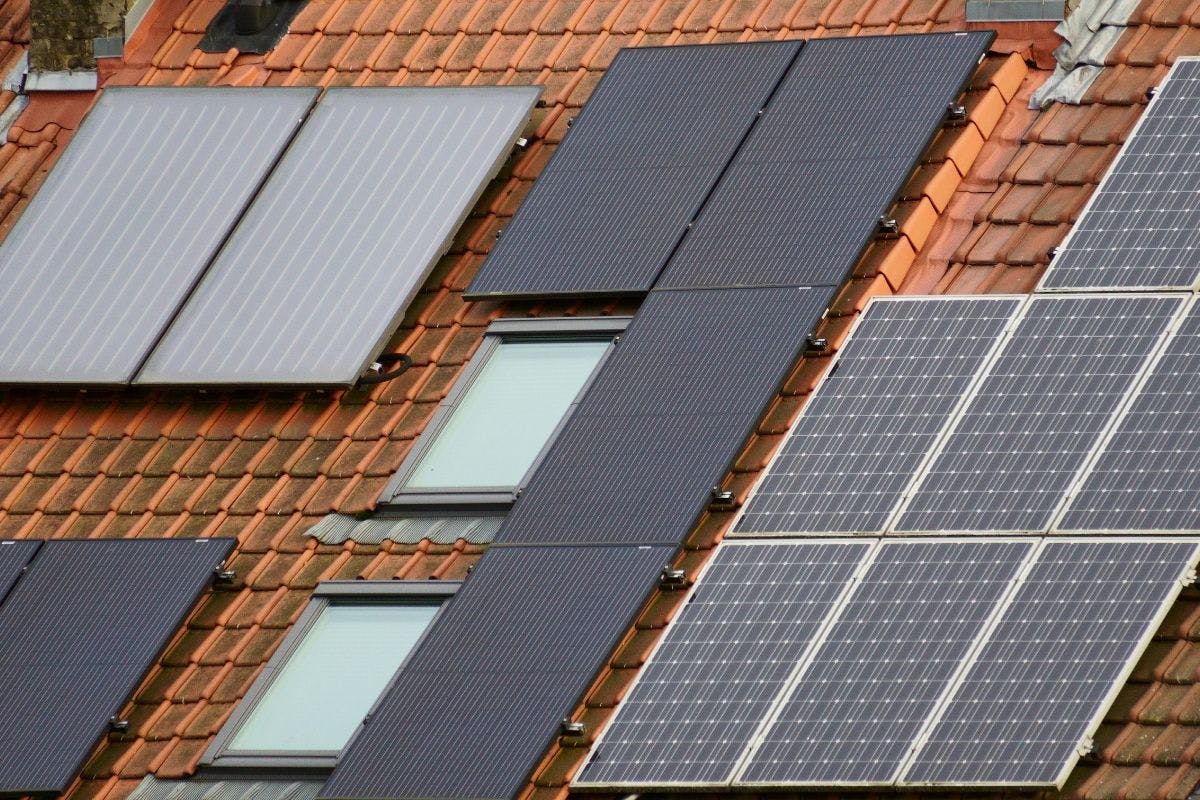Blue vs. Black Solar Panels: Why Most Panels Are Black
Last edited

Author
Andrew Giermak
Solar and Electrification Writer and Editor

Editor
Andrew Blok
Electrification and Solar Writer and Editor

Solar panels can come in different colors, but most people get black solar panels. This is not just an aesthetic choice; it’s due to the materials and manufacturing process of the silicon cells, which prioritize efficiency, which means you save the most money for decades to come.
Because most homeowners prioritize lowering energy costs, nearly all home solar panels installed today are the more efficient black solar panels.
See how much you can save by going solar with Palmetto
Why are most solar panels black and blue?
You may be surprised to learn the color of solar panels is not just an aesthetic choice by the manufacturers. Solar panels are black and blue because those are the natural colors that silicon becomes during the manufacturing process. There are two primary kinds of solar panels commercially available: monocrystalline and polycrystalline.
Black solar panels = monocrystalline
Monocrystalline solar cells are made out of silicon where each solar cell is a single crystal. This makes them considerably more efficient, especially since black is more light-absorbent than blue. As costs come down across the industry, most solar panel installations use black monocrystalline panels because people want the increased efficiency they provide. Nearly all residential solar panels installed today are black, monocrystalline models.
Blue solar panels = polycrystalline
Blue solar panels are made from polycrystalline silicon where a single cell contains several silicon crystals, and the way those crystals interact with sunlight makes them appear blue. The multiple crystals slow conduction, resulting in blue polycrystalline solar cells being less efficient in generating electricity. Polycrystalline technology used to be cheaper than monocrystalline, which is why you are more likely to see blue panels in older installations.
See how much you can save by going solar with Palmetto
Do solar panels come in different colors?
The short answer is: Yes, residential solar panels are available in a variety of colors.
The long answer is more complicated. In general, colored panels are more expensive and generate less power. As a result, they’re often made by smaller, specialty manufacturers. If a commercial solar panel manufacturer wants to make solar panel colors other than blue and black, they have to use dyes or coatings, which make the panels less efficient. In fact, colored solar panels created with this method are as much as 45% less efficient than the standard blue or black solar panels. This math would slow down any return on investment you experience with your solar PV system. Most customers choose solar to lower their energy costs, so they don’t want fancy solar panels that cost more and work less effectively.
Solar panel variety is being experimented with to create more efficient colored panels, as well as a wider range of colors to suit more environments, color schemes, and aesthetics.
For example, researchers in the Netherlands have developed a soft-print lithography technique that allows panels to reflect a specific color. Unfortunately, this still reduces efficiency, but only by about 10% compared to the 45% of other coating methods. With continued improvement, they aim to reduce that loss in efficiency to as little as 2%.
Does the Tesla Solar Roof offer colored solar panels?
In 2017, Tesla announced it would release multiple colors and styles of Solar Roof, photovoltaic panels designed to look like regular roof tiles. Presently, Tesla Solar Roof tiles and Tesla’s solar panels come in black .
However, solar roofs still have some aesthetic advantages for those who can afford the higher price tag.
Can you get solar panels in different colors?
While it’s technically possible, it’s almost certainly the best choice to go with high-efficiency black solar panels.
Dyes and coatings don't handle tough conditions well, so it’s likely colored panels could lose their vibrancy over a panel’s 25-year lifespan, cost homeowners more, and perform worse than monocrystalline solar panels..
Most solar panels are black or blue as a result of their specific manufacturing process. Moreover, manufacturers, installers, and the majority of customers are focused on efficiency, so installers are often reluctant to work with colored solar panels. You’d need to find an installer willing to work with you at the design phase to create a PV system that uses those lower-efficiency panels and still creates the most power possible.
If you’re ready to install a solar power system on your home and start saving money with clean, renewable energy, talk to Palmetto today. Get started with our free solar savings tool and see how much you could lower your electricity bill by going solar.
Whether going solar or not, there are ways to save energy and save money at home. Using the new Palmetto app is another easy, free way to track energy usage, see what you’re spending, and see numerous ways to save.
See what solar can do for you:
Frequently asked questions
Can you get solar panels in different colors?
You can get solar panels in custom colors other than black or blue. You are likely to pay more and get panels that are less efficient, lengthening your estimated solar payback period.
What is a solar payback period?
A solar payback period is the time it takes for your savings from going solar to match your purchase and installation costs. A typical solar payback period is 6-10 years. Solar panels efficiently generate electricity for 25 or more years.
What color of solar panel is the best?
Black solar panels are typically the best for home roof solar panels. Black panels have the best energy generation efficiency and are the best value considering the upfront cost and efficiency in the long run.
Why are most solar panels black?
Black monocrystalline solar panels have the best efficiency and are the most cost-effective to manufacture in large quantities. Black is also more light-absorbent than blue.


